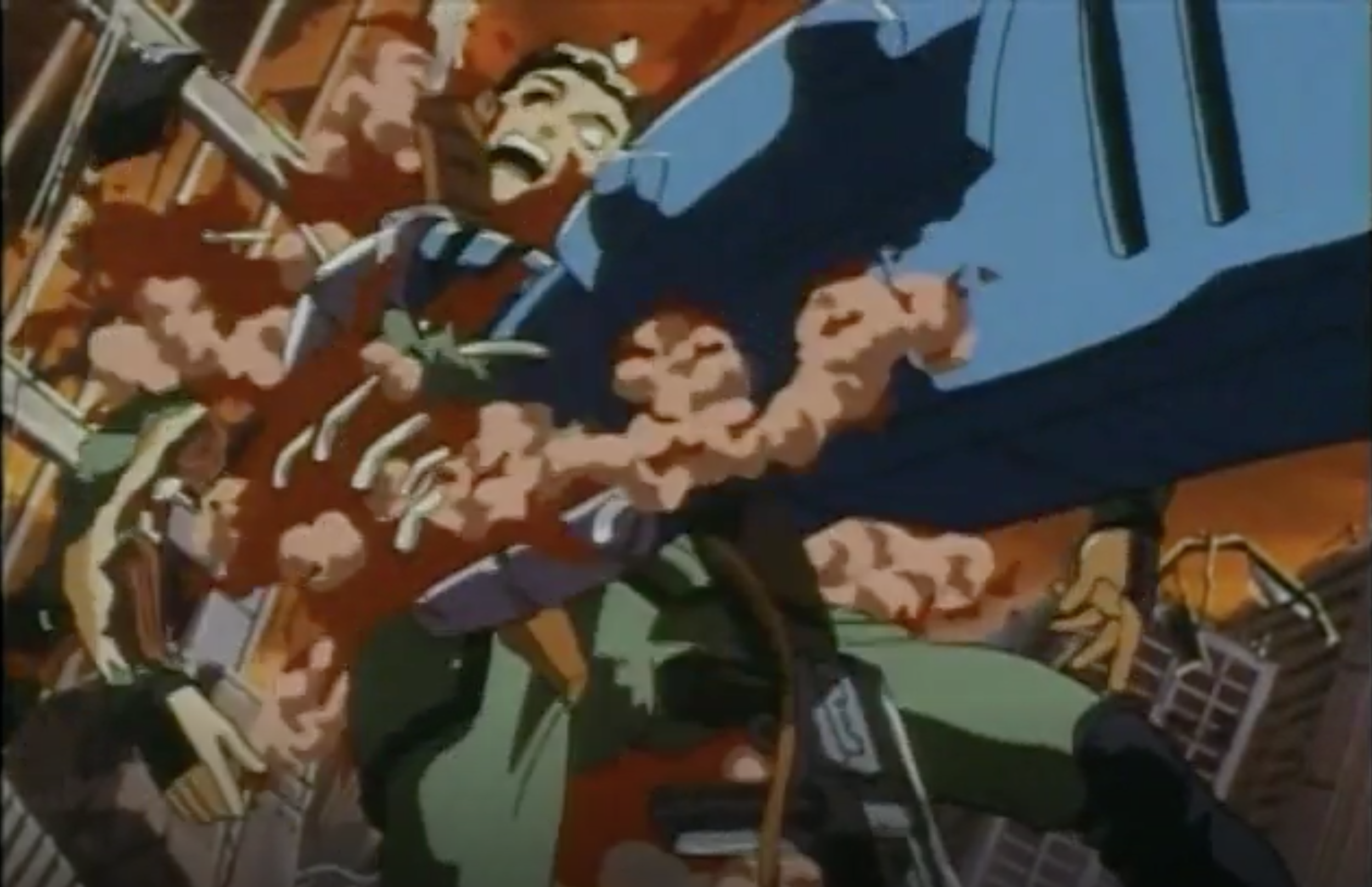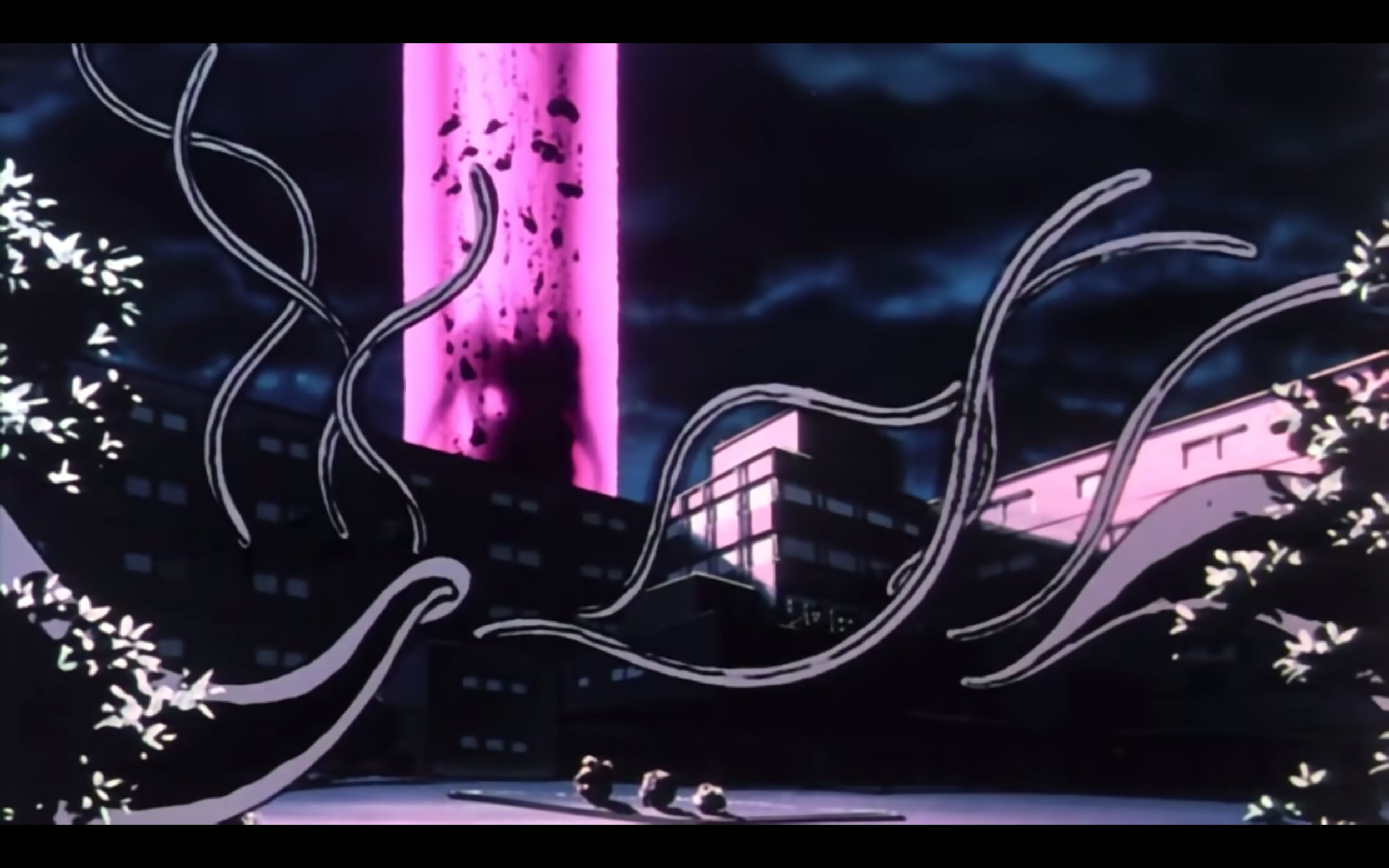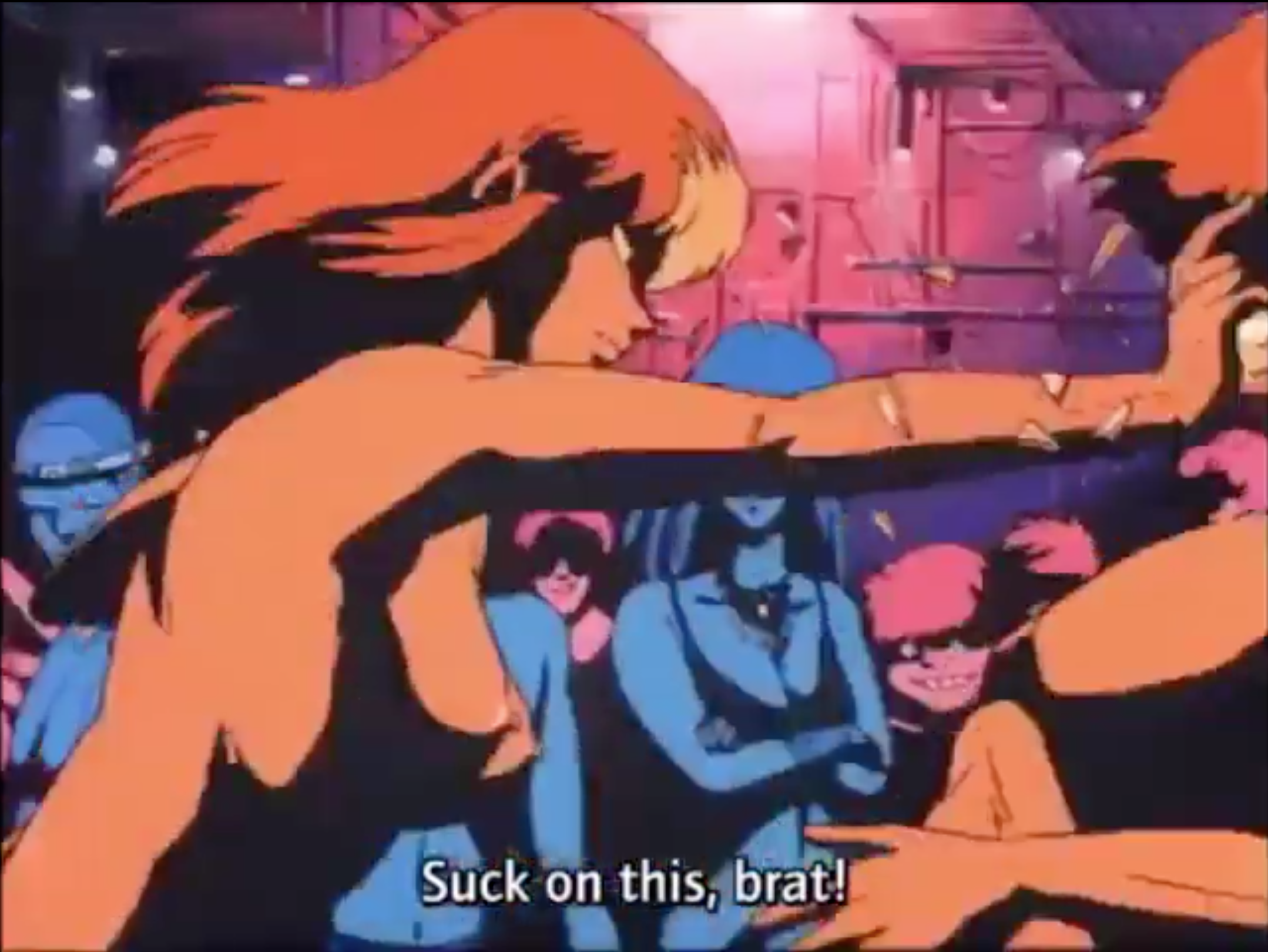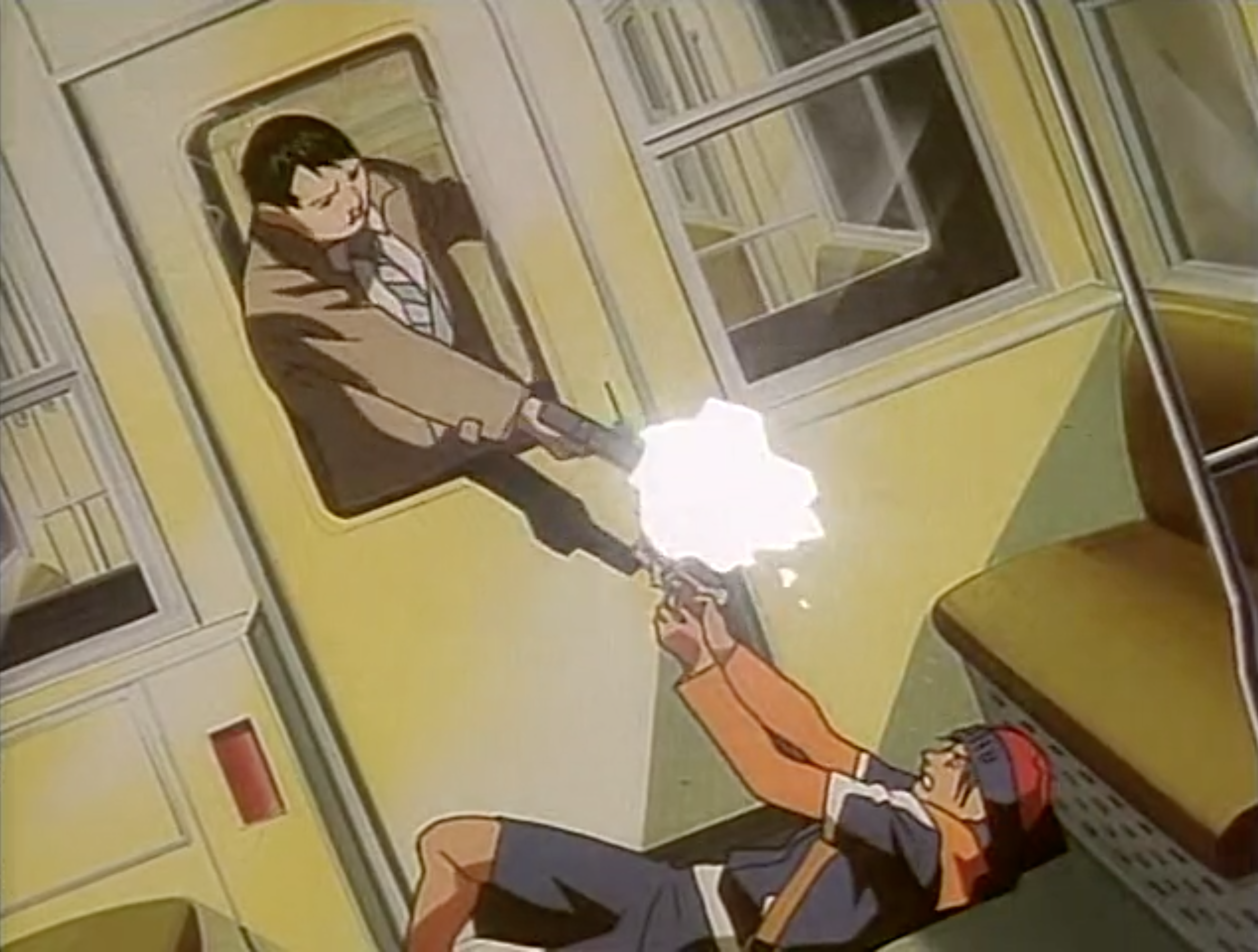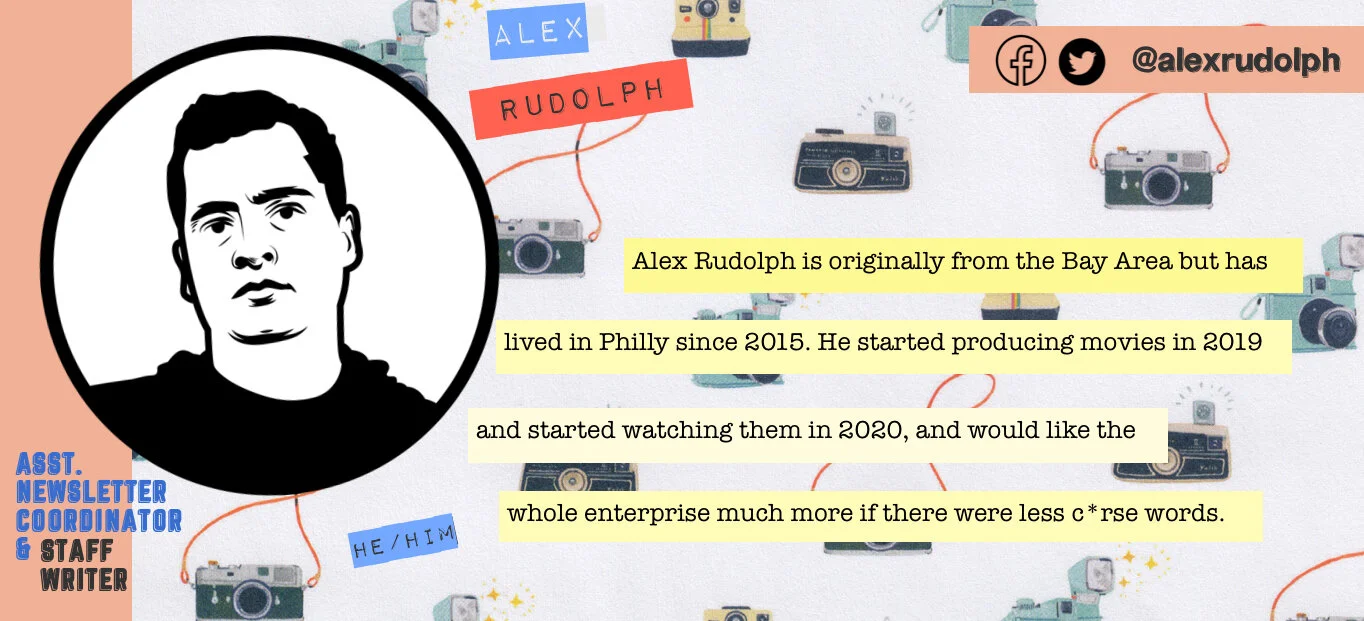Ani-May: My weekend with "extreme" anime
This month, we’re celebrating animation from Japan–better known as anime–by looking at some of our favorite works or ones we hope will provide new perspective. This also ties into our upcoming Spring issue of the zine, which is all about gaining new insights through films that are ‘foreign to us.’ See all the articles here.
by Alex Rudolph, Staff Writer
Content warning: sexual violence. No images of the tentacle porn, but a lot of discussion of it. There will be some shots of animated nudity.
Last week, my neighbor and I talked about the TV the people on our block watch. We don't stalk around, cupping our hands against windows, but every home on our side of the street is designed the same way, with a living room immediately behind the front door and a kitchen behind that. If you're going to put a TV on your first floor, it's going to be next to the street-facing window. If you walk your dog four times a day, as my neighbor and I do, you're going to walk past a lot of windows and, through no desire to play voyeur, you're going to see a lot of lit up TVs. One house is always watching Drag Race, the family at the end of the block usually has a 3D animated Mickey Mouse cartoon on in the mornings, etc. And I froze up, because I knew I had volunteered to write an article that would splash tentacle porn all over my only TV. What would the community think?
I've always wanted to like anime more than I do. The things I've connected with (Akira, Samurai Champloo, the Gundam 08th MS Team DVDs I bought with Bar Mitzvah money twenty years ago) have been great, but the medium has always kept me at arm's length. I'd love a series' action or basic premise and then the tone would fly off in an awkward direction or the story would stall or I'd get to Mr. Popo.
As much as I enjoy Studio Ghibli and Satoshi Kon, I've never found enough stuff like, say, Paprika to make me watch more than a couple hours of anime every year. But I've always been fascinated by the culture and I've always been repulsed by its more extreme elements, which is to say the tentacle porn, the treatment of women, the sexualization of little girls, the way so many stories have a rough, sometimes unexamined undercurrent of fascism. For MovieJawn's Ani-May, I wanted to dig into that for the first time in my life and see what happens when you jump off the deep end and come to the harshest anime as a person who doesn't even consume much of the mainstream stuff.
I reached out to Ryan, who let me know Dan Santelli would be the best person to talk with. I love movies and consider myself well-watched, but feel safe saying Dan has seen a few hundred more films than I have. His guidance was greatly appreciated.
It's worth underlining these are all things I explicitly asked Dan to recommend. I didn't come to him saying "hey, I like Pokemon," only to get a list of ten hentai movies. I said "I have a deep aversion to this stuff but it's intellectually interesting to me and I've never engaged with it. What would give me a good survey of the VHS anime genre and really ruin my weekend?" I'm thanking him for writing back, not telling you my colleague rickrolled me into opening up nightmare fuel. I told Dan I wanted to watch the stuff that made parents worry anime was going to make their kids violent pervs instead of just normal tweens who liked to wear silk Goku shirts. I wanted to watch the videos and DVDs I'd get glimpses of in the Tower Records anime section and think "Is it even okay to own this? Would the clerk put me on a list if I brought this to the register?"
These are six of the nine films he recommended.
M.D. Geist (dir. Hayato Ikeda, 1986)
The credit up there says Hayato Ikeda, but, while trying to figure out whether I wanted to watch the original or director's cut, I discovered M.D. Geist was actually directed by a then-23-year-old named Koichi Ohata. Ohata hadn't made a movie before (he came up designing vehicles for other anime series) and Ikeda's name was put on the project to add legitimacy. He didn't have much of a resume, he was just older than the 23-year-old actually calling the shots. Oh, and the screenwriter was 22.
The first thing you see in M.D. Geist is a blown out post-apocalyptic city. We're on a post-Earth planet called Jerra, because humans have mastered space travel but haven't been able to shake the need to blow other humans up. We lower down into the city and watch soldiers get viciously torn apart by mechs. It looks fucking awful.
It looks so gory, in fact, that I thought I was watching an anti-war film. I wasn't under the impression Geist was as sophisticated as something like Come & See, but the viscera is sickening enough that the uneasiness I felt seemed like the point. My understanding of anime is limited but, from what I've seen, so many foundational series like Gundam seem to be stridently against war, while a handful of modern series revel in being as militaristic as possible. The further I got into Geist, the clearer it became I was watching an entry in the latter camp.
For a movie this slapdash and niche, that isn't a terrible thing. I can enjoy Geist the way I would Commando or Cobra. And like Cobra, it turns out M.D. Geist's title refers to a dude with a ridiculous name. This is how we're introduced to Most Dangerous Geist:
A "clonn," Geist was part of the Most Dangerous supersoldier program, but he was too Most Dangerous and his creators imprisoned him on a satellite. He breaks out of his space prison, takes out a plane with a grappling hook gun and walks around with a bullet hole in his brain. If a movie is going to try this hard to be badass, as the great Fist of the North Star did, I'm going to love it for that. My ideal action star is the hero of Riki-Oh: The Story of Ricky, who can tie his own sliced arm tendons back together and play a full song by blowing on a blade of grass. Anime's lack of subtlety can be alienating. I'll think I'm watching a quiet drama and a giant bead of sweat will run down a character's face or they'll hear something awkward and fall over on the ground, twitching. Geist relishes in being obvious, and that becomes inviting in its own way.
There isn't much of a story here, but, essentially, Geist and some bandits spend one long fight scene trying to deactivate a mega-weapon called Death Force, which is set to go off and will summon an endless stream of murder robots. There are four or five characters and each of them double crosses the others. Geist reaches Death Force, activates it and laughs as the bandit he's teamed up with freaks out. Credits roll. There wasn't a follow-up for another decade.
In the most generous reading of Geist I could give it, the story is confusing because war is confusing, and the main character damned the planet to murder robot massacre against his better judgment because he isn't logical, just bloodthirsty. The more realistic take is that Geist was directed by a 23-year-old who previously designed sci-fi war machines and written by a 22-year-old who hadn't previously done anything, and they were more interested in animating a supersoldier stabbing a guy with a knife/grenade combo than they were in coming up with a cogent reason for him to do that. I don't blame them. I don't think that's a terrible thing.
Looking this up after watching it, I found out anime fans think M.D. Geist sucks.
Urotsukidoji: Legend of the Overfiend (dir. Hideki Takayama and Shigenori Kageyama, 1987)
Enjoy that screenshot, it's the only clean thing I could find in Legend of the Overfiend, a movie I would be happy to have never seen.
I can't pretend I didn't know what I was getting into, though. Here's Dan, describing it in his initial email: "The Real Deal, an OVA that legitimately feels like anime projections from the mind of a psychopath; a 103-minute NC-17 cut is on YT, but try to track down the 145-minute(!) version."
An "OVA," for the record, is an Original Video Animation. It's a direct market movie, straight to VHS or DVD. I understand why you wouldn't give Legend of the Overfiend a theatrical run.
And I couldn't find a streaming version of the 145-minute cut. I could buy a copy on eBay, but it was expensive and, perhaps more importantly, I didn't want to own this.
Legend of the Overfiend is biblically convoluted. Demons, beastmen and regular human live in separate realms, but the barriers between those realities weaken once every 300 years. There's a chosen human, a beastman trying to find him and that's as much as I understood. The screenshot I took represents a turning point, where a beastman has died, come back to life in a hospital and raped his nurse, setting forth a bouquet of tentacle dicks. This movie, and the manga it's adapted from, revolutionized sex in anime and essentially created the tentacle porn genre. It's as horrible as that sounds.
There's an incredible amount of sex, even in the somewhat edited version I watched, and it's all violent and humiliating. Guys jerk off while secretly watching girls in locker rooms, girls offer themselves to guys who just raped other women in front of them and it never ends.
You can make the argument that pure shock value is in and of itself worthwhile in a repressed society, but I don't know. There's a difference between the Sex Pistols wearing swastikas on their jackets and Fugazi treating people with dignity and having a fucking point. You can rage against the normies all you want, but shoving sexual violence into every scene of your shitty movie isn't actually going to change anything.
That was the idea, at least. In Japan, you can't show genitalia. You can show breasts, but no nipples. People can get naked, but you can't show an erect dick. This isn't solely in animation either–censors make sure live-action pornography is as pixelated as the cartoons are. Legend of the Overfiend artist Toshio Maeda got around this by drawing tentacles instead of penises. His big contribution to manga was a loophole where fish monster limbs penetrated vaginas and you never had to see a gross dick.
I usually like when you can see the strings. It's fun to watch Indiana Jones shoot a swordfighter and find out that only happened because Harrison Ford was sick and couldn't do anything else. And so it's kind of interesting, historically, that tentacles have sex with women in manga and anime because penises were censored and tentacles look enough like that to get the idea across. I just didn't get anything out of watching that happen.
Intentional or not, the movie comes off like the manga's creator is completely terrified of sex. If you got kicked in the head by a horse, you might find all the tentacles erotic, but they're also always presented here as tools of destruction. When a demon reaches climax, he's as likely to rip his victim apart as he is to ejaculate. You have to watch this and imagine that Maeda is afraid of his own crotch. Maeda is proud to be the tentacle hentai guy–he wants "Tentacle Master" on his tombstone. The first question is "Why do you think evil, sentient tentacles are a normal stand-in for genitalia?" and the second is "Why is genitalia a destructive weapon?"
It's clearly sexist–there aren't any men getting violated here, it's always women on the receiving ends of horrific sexual violence–but it's also clear Maeda feels men are part of the problem. Inflicing that violence is in our nature. This could make for an interesting, albeit still unwatchable movie, if the violence wasn't animated in a way that's meant to be titillating.
I found an interview between Maeda and Anthony Bourdain from an old episode of Bourdain's show Parts Unknown, and Maeda explains how extreme his work is by saying "In Japan, you can't be rude in public. But you need to just let off steam, so for me the manga is one way to do that." This is like saying "I'm not allowed to swear at work so I take shits in the middle of Trader Joe's on weekends." The response is nowhere near proportionate to the restriction. "When my bus pass doesn't scan and the driver tells me I have to pay with change, I kidnap and maim politicians."
There's also an interview with Maeda on Vice. He says that "It's a man's dream to have a bigger, thick thing in your crotch." Knowing this is on some level wish fulfillment makes me sick. In that interview, he also discusses that tentacles aren't bound by gravity (?) and so he was able to show women being raped from all angles. They could float on the end of a tentacle and he could draw cool poses. I think he's a very dumb person. Not bad, not evil, just a dope. He thinks he's saying something, but then so did every angry kid who ever told this parents they didn't understand how important Korn was.
Toward the end of the interview, he says he doesn't get off on any of this, but the fact that he's kept returning to this well for 30 years means there's a reason behind it. He's either creatively bankrupt and can't come up with a second idea or there's something motivating the thousands of hours he's put into his tentacle rape career. He cannot or will not admit it. I don't have much use for R. Crumb, but at least he's upfront about exploring his id when he draws something gross. I'll defend Berserk, I'll defend Johnny Ryan, I think this is only a historical curiosity.
But also, why not admit it? You've made all of this stuff, you've explicitly tied your name to a genre called tentacle rape, I don't think you're saving face at this point if you say you don't get any pleasure from any of it. I can't believe I'm writing this, but that's probably worse than showing everybody your masturbatory fantasies. Maeda wakes up every morning, sighs, and goes to work at the tentacle porn factory. If you have a unique kink, fine. As long as you aren't hurting anybody in the real world and violating anybody's real consent, draw away. I don't have to engage with it. But you're an irredeemable idiot if you're drawing this much mondo sexual violence and then turning around and saying "You know, this isn't even my thing."
Part of my discomfort can be chalked up to a difference in the way American and Japanese animation is conceived. The general idea with Western comics and cartoons is that you're watching things happen from a distance while Japanese comics and cartoons put you in the protagonist's shoes. In his book Understanding Comics, Scott McCloud talks about how we rarely fly with Superman. The "camera" is mostly on the ground or a little zoomed out. But when Astro Boy flies around in manga and anime, we're there behind him, pressed right up close. Legend of the Overfiend's subject matter would make me sick no matter what, but it doesn't help that I'm supposed to be this close to the action. In a film devoid of empathy, it could stand to be a little less technically empathetic.
Devilman: The Birth (dir. Umanosuke Iida, 1987)
Devilman: The Birth opens with a truly disturbing scene of fairies getting eaten by monsters and carnivorous plants in a prehistoric world. The disturbing part isn't even the violence, it's that the music stays in lush orchestral mode as the violence is happening. Believe me, violence isn't that disturbing anymore. I've seen Legend of the Overfiend.
I really liked how impressionistic the opening was. Fairies are digested by Lovecraft eyeball abominations, some explorers are stuck in an At The Mountains of Madness-style ice cave, a young boy finds his pet rabbits murdered, he goes to school and some bullies mess him up with a bike chain. The tone is locked in, even if I have no idea what's going on. Reading the plot description later, I realized I even got all of that wrong–the fairies were angels, the monsters were demons and I had been watching a battle between heaven and hell.
Akira, the rabbit kid, is soon forced to wear a mask that looks like a science fair volcano and it gives him visions of the entire history of demons. This is the second film, after Overfiend, to base large parts of its plot on the idea that there's an evil sub-race of demons. This happens in Western media, too-- The Lord of the Rings has its evil, "savage" orcs, its heavenly Aryan elves (I'm not going to go into the anti-Semitism of the dwarves)-- so I'm not just saying this is an anime thing, but it's interesting it's shown up so much. Japan's racism is as well-documented as America's and I wonder if it gets reflected in its cartoons in more subtle ways than "Bugs Bunny wearing blackface."
Akira has to become a demon to fight demons, for reasons that are never explained. Some of the demons look like vulvas
and some of them look like vulvas with teeth
Devilman's big climax hits as Akira gets into a fistfight with some demon/dirtbag folks at a heavy metal club. Akira gets pushed into a woman's breasts,
she taunts him and beats his ass,
points and laughs at him a little longer, and then her breasts turn into monster heads.
In a movie with so much sexual imagery, this is as close to anybody gets to sexual contact. Akira responds to the humiliation by transforming into Devilman and destroying the woman, because, like modern Hollywood blockbusters, Devilman: The Birth only fully introduces the thing it's been building toward in its title in the last few minutes before the movie ends. I would have watched the next Devilman film if I had forced myself into another anime weekend. There's enough going on here, and enough of what's going on isn't over-explained to the point of nonsense, that I'm interested in seeing where it goes. The central thrust is "let's show you bizarre, phantasmagorical weirdness," but without Overfiend's sexual violence. It's about sex, but the themes are explored from a naive perspective instead of an old perv's viewpoint. Turns out you can make sex uncomfortable without also fantasizing about watching every female character get raped. What a revolution.
Wicked City (dir. Yoshiaki Kawajiri, 1987)
Turns out '87 was a great year for anime I can watch once and then happily never touch again! Certainly, it was when the dam broke on the "secret horny demon races live among us" plot point.
In the first ten minutes of Wicked City, a man brings a woman back to his apartment for a one-night stand. They have the kind of sex children think adults have (she takes off her clothes, unzips his pants and says "he's a healthy one, let me see if I can wake him" before sharply exhaling on his penis while he thinks "My god, has this wild woman been hiding under that demure exterior all this time?"). And then, of course, her vagina turns into a mouth, she makes fun of him and crawls out the window like an insect. Go ahead and look at that first screenshot for Wicked City again and note where the spiderweb is coming from.
We learn the guy, Taki, works above the board as a tech salesman while secretly running missions as an agent for the Black Guard, a sort of Men in Black that keeps demons from getting too involved in humans. He's assigned to work with a demon (presenting as a beautiful woman) named Makie and a small elderly lech named Mayart. I love this character type, Japan, please always insert panty-sniffing, groping old man into more things!
So much of the anime I've watched, here and in other contexts is tonally inconsistent. There's always a distance between the material and me. The demon sex and upcoming action scenes are on different ends of the corniness spectrum, but they have the same grim feeling. A smoking thirty-something special agent has to get shit done. The horny moleman's slapstick feels completely out of place and just like that, 20 minutes in, I'm not sure what I'm watching.
The film looks beautiful, though. The figures are all stiff, but the way they're lit and the way they glide through dark streets is reminiscent of what Michael Mann was doing around the same time. It's all soft neon colors and knock-off Tangerine Dream synths, the kind of feeling you see represented a lot on Bandcamp and Instagram. The director would go on to make a few Animatrix shorts, which makes sense. Aesthetically, The Matrix is a dirtier, less lush version of what Wicked City had done a decade earlier.
Like Devilman, Wicked City is mostly about how women use sex to accomplish terrible things. There are male demons, but they fly around with superpowered fighting techniques and weapons. The female ones have vagina mouths. One masquerades as a massage therapist and absorbs Mayart during a happy ending.
Don't worry, Mayart survives! Makie sacrifices herself to save him, which of course means she gets raped in the demon world. If I had been taking a drink every time a character got raped in one of these movies, I would have had a perfect excuse to stop watching them. I'd be dead. I would have died.
And now I face the conundrum–I had wanted to watch an anime film where a woman doesn't purely show up to, at best, distract and, at worst, destroy a male protagonist. I got that here. Makie is designed to be kind and selfless and she has agency. She uses that agency to save a male protagonist and doom herself to sexual assault.
During one of Wicked City's beautifully animated car chases, a windshield is speckled with spiderwebs that look like cum, and that's about as subtle as we get.
Kite (dir. Yasuomi Umetsu, 1998)
We pause here to thank Tubi for not allowing porn. I watched a 47-minute-long subtitled version of Kite on the streaming platform, but apparently there's a 60-minute-long version that's much more explicit and has been banned in Norway for being too close to child pornography. I had to see a teen girl nude, post-coital, but I didn't have to watch her have sex, and for that I smile in the grace of America's number one purely ad-supported streaming service (seriously, though, there's a ton of great stuff on Tubi).
Kite opens with a famous comedian feeling up a young girl on an elevator. She's holding a suitcase, it transforms and pops a gun out and she shoots the guy in the head. And then his body blows apart from the inside and we're watching a slightly less problematic version of Promising Young Woman.
The girl is Sawa, and she's a tiny assassin being manipulated by the two corrupt cops who killed her parents. One of them is having a sexual relationship with her. The movie was originally two OVAs, and the original release format shows. Sawa kills a person, spends too long idly talking to her handlers and budding love interest (and fellow child assassin) Oburi, and then a giant gunfight breaks out.
The discussions are empty and one-note, only there to buy time, but the action scenes are cool enough to make up for all the emptiness they've been packaged with. The evil cops send Sawa to kill a cross between 70s Robert De Niro and late-80s Bruce Willis (who has a twin with De Niro's mole on the other side of his face) and the ensuing fight leads directly to two people jumping out a window on an impossibly tall skyscraper.
The skyscraper sequence is well choreographed and tight, as is a cramped shootout in a subway car. As the action intensifies, the score spirals out into screeching free jazz, something Cowboy Bebop was also doing effectively in the 90s. The pacing and sense of space is phenomenal. If we stayed in these scenes for the full hour, we'd be getting somewhere.
As Sawa's abduction comes to light and her rapist captors start to feel the heat, another cop casually notes that the pre-teen Sawa was "an unusually sexy girl." Like "whoever wound up with that 11-year-old sure is lucky."
Is the point that we're in an amoral world? ACAB? Maybe. The film ends with Oburi getting murdered by another previously-unseen tween assassin and Sawa waits, thinking he's going to come take her away where they can be happy. It's a nihilistic film, to be sure, and I'm not going to complain about that.
But I keep returning to the stuff I didn't see. I keep returning to the fact that there were 13 minutes of sex in the original cut. On reading more about Kite, I found out Umetsu was only able to receive funding for his film when he promised to make the movie more erotic. The budget was contingent on him animating the child porn. We can talk about how hard it is to get enough money together to make a movie, but "I agreed to include 13 minutes of child rape" seems like a line it'd be pretty easy to avoid crossing as you compromise your vision. Whatever the original script and storyboards look like, the final version of Kite included all of that when it was released.
At best, the movie's sloppy in its messaging. At worst, it's hypocritical, showing you how shitty everybody in its world is while also throwing in an Irreversible-level of rape commissioned not because it would make a point but because that's what the investors wanted to see (or at least thought they could more successfully market). There are some stunning action set-pieces here, and are worth seeing as long as you're watching the censored cut and you're willing to hit fast-forward whenever anybody tries to sound smart.
Urotsukidoji: Legend of the Demon Womb (dir. who gives a shit, who cares when)
After Kite, I thought it might be a good idea to watch the sequel to Overfiend. Dan had warned it felt tryhard, but then every anime feels tryhard to me. Specifically, Dan had written "opens with a Hitler cameo and a Nazi Death R*pe Machine. Too much of a tryhard for my taste, but worth it for shock value." Worth it also, I thought, because the more I could watch, the more context I would have and the better my article would be. If I'm trying to understand extreme anime, and if I'm never going to watch another movie like Overfiend, I may as well go all-in.
I found this Urotsukidoji, subtitled Demon Womb, on one of those terrible websites that lets you stream an otherwise inaccessible movie after you click through ten pop-ups, and even then you have to contend with whatever "you CANNOT play this game without coming" ads that start obscuring the picture after the film finally starts.
Demon Womb began and I started clearing away the porn spam so I could take a screenshot of zombie android Hitler. His face was Frankensteined together and his left arm was robotic. Hitler fired up the rape machine and a woman began screaming and I said "Oh, fuck this" to a room otherwise occupied only by my dog and I closed the tab and enjoyed the rest of my night, comfortable behind the walls of whatever meager measure of taste I still had.




